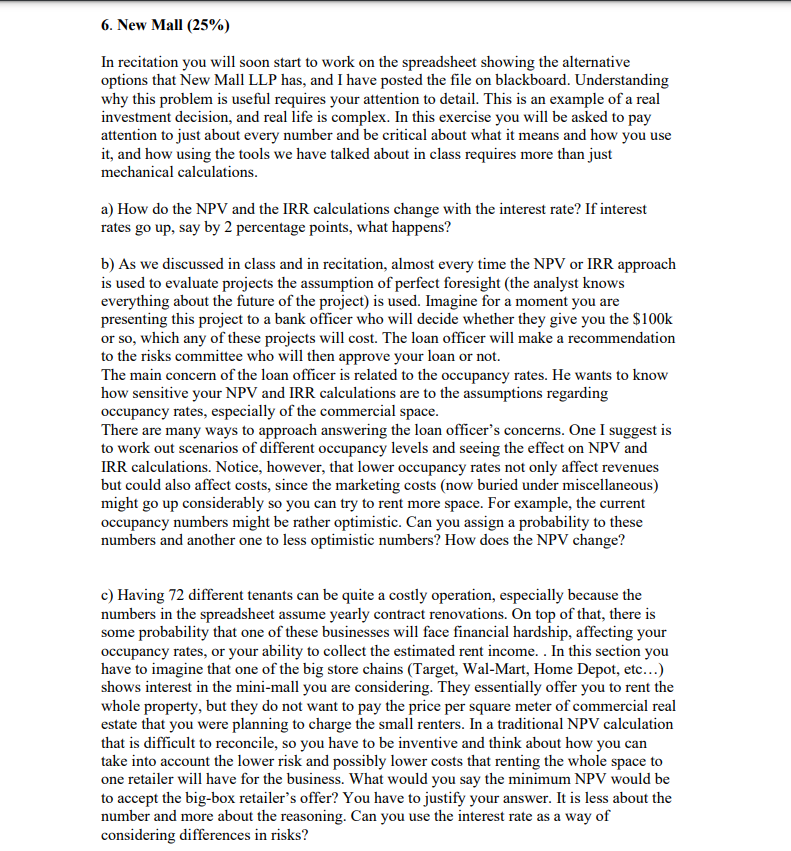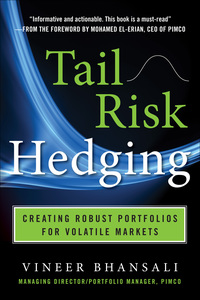 undefined
undefined
6. New Mall (25%) In recitation you will soon start to work on the spreadsheet showing the alternative options that New Mall LLP has, and I have posted the file on blackboard. Understanding why this problem is useful requires your attention to detail. This is an example of a real investment decision, and real life is complex. In this exercise you will be asked to pay attention to just about every number and be critical about what it means and how you use it, and how using the tools we have talked about in class requires more than just mechanical calculations. a) How do the NPV and the IRR calculations change with the interest rate? If interest rates go up, say by 2 percentage points, what happens? b) As we discussed in class and in recitation, almost every time the NPV or IRR approach is used to evaluate projects the assumption of perfect foresight (the analyst knows everything about the future of the project) is used. Imagine for a moment you are presenting this project to a bank officer who will decide whether they give you the $100k or so, which any of these projects will cost. The loan officer will make a recommendation to the risks committee who will then approve your loan or not. The main concern of the loan officer is related to the occupancy rates. He wants to know how sensitive your NPV and IRR calculations are to the assumptions regarding occupancy rates, especially of the commercial space. There are many ways to approach answering the loan officer's concerns. One I suggest is to work out scenarios of different occupancy levels and seeing the effect on NPV and IRR calculations. Notice, however, that lower occupancy rates not only affect revenues but could also affect costs, since the marketing costs (now buried under miscellaneous) might go up considerably so you can try to rent more space. For example, the current occupancy numbers might be rather optimistic. Can you assign a probability to these numbers and another one to less optimistic numbers? How does the NPV change? c) Having 72 different tenants can be quite a costly operation, especially because the numbers in the spreadsheet assume yearly contract renovations. On top of that, there is some probability that one of these businesses will face financial hardship, affecting your occupancy rates, or your ability to collect the estimated rent income. In this section you have to imagine that one of the big store chains (Target, Wal-Mart, Home Depot, etc...) shows interest in the mini-mall you are considering. They essentially offer you to rent the whole property, but they do not want to pay the price per square meter of commercial real estate that you were planning to charge the small renters. In a traditional NPV calculation that is difficult to reconcile, so you have to be inventive and think about how you can take into account the lower risk and possibly lower costs that renting the whole space to one retailer will have for the business. What would you say the minimum NPV would be to accept the big-box retailer's offer? You have to justify your answer. It is less about the number and more about the reasoning. Can you use the interest rate as a way of considering differences in risks? 6. New Mall (25%) In recitation you will soon start to work on the spreadsheet showing the alternative options that New Mall LLP has, and I have posted the file on blackboard. Understanding why this problem is useful requires your attention to detail. This is an example of a real investment decision, and real life is complex. In this exercise you will be asked to pay attention to just about every number and be critical about what it means and how you use it, and how using the tools we have talked about in class requires more than just mechanical calculations. a) How do the NPV and the IRR calculations change with the interest rate? If interest rates go up, say by 2 percentage points, what happens? b) As we discussed in class and in recitation, almost every time the NPV or IRR approach is used to evaluate projects the assumption of perfect foresight (the analyst knows everything about the future of the project) is used. Imagine for a moment you are presenting this project to a bank officer who will decide whether they give you the $100k or so, which any of these projects will cost. The loan officer will make a recommendation to the risks committee who will then approve your loan or not. The main concern of the loan officer is related to the occupancy rates. He wants to know how sensitive your NPV and IRR calculations are to the assumptions regarding occupancy rates, especially of the commercial space. There are many ways to approach answering the loan officer's concerns. One I suggest is to work out scenarios of different occupancy levels and seeing the effect on NPV and IRR calculations. Notice, however, that lower occupancy rates not only affect revenues but could also affect costs, since the marketing costs (now buried under miscellaneous) might go up considerably so you can try to rent more space. For example, the current occupancy numbers might be rather optimistic. Can you assign a probability to these numbers and another one to less optimistic numbers? How does the NPV change? c) Having 72 different tenants can be quite a costly operation, especially because the numbers in the spreadsheet assume yearly contract renovations. On top of that, there is some probability that one of these businesses will face financial hardship, affecting your occupancy rates, or your ability to collect the estimated rent income. In this section you have to imagine that one of the big store chains (Target, Wal-Mart, Home Depot, etc...) shows interest in the mini-mall you are considering. They essentially offer you to rent the whole property, but they do not want to pay the price per square meter of commercial real estate that you were planning to charge the small renters. In a traditional NPV calculation that is difficult to reconcile, so you have to be inventive and think about how you can take into account the lower risk and possibly lower costs that renting the whole space to one retailer will have for the business. What would you say the minimum NPV would be to accept the big-box retailer's offer? You have to justify your answer. It is less about the number and more about the reasoning. Can you use the interest rate as a way of considering differences in risks
 undefined
undefined





